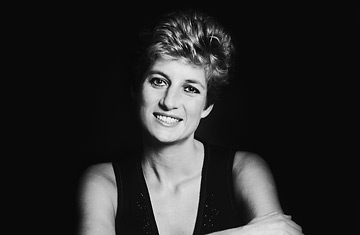
Princess Diana, Princess of Wales (1961 - 1997) posing against a dark background, circa 1995.
(2 of 5)
The prince has also taken steps to make a place for his longtime love Camilla Parker Bowles in his family life. He has had some help. Her introductory tea with Prince William, 16, at Charles's St. James's Palace apartments on June 12, leaked to the press as a chance encounter, was in fact orchestrated by William. (Harry's introduction, at Highgrove, took place a few weeks later.)
It's a scenario Diana might have foreseen. "She would be rather irritated that the boys have met Camilla, especially as they probably quite liked her," says Majesty's Seward. Still, says a Palace insider,"at the end of her life, Diana was more resigned to Charles's private life and wished him well."
According to her wishes, Charles enrolled Harry at Eton, where he will reside in William's house. As for William, "Charles wants to introduce him to his royal role, albeit gently," says Archer. For now, Charles's main goal is to provide the emotional support his sons need to heal. "Charles and the boys," Archer says, "are a close family."
You've got to hand it to her: over the past six years, Parker Bowles has been condemned, resurrected and buried again. Yet she has come through it all with her humor intact, even using — prior to the tragedy in Paris — Diana's epithet on herself by answering the phone in her Wiltshire home, "Rottweiler here." Friends aren't surprised. "Camilla is very good at laughing at herself," says author Jilly Cooper. "That's what has saved her through the appalling mauling she has had."
Nor has she ever been anything but discreet. After news of her private June 12 meeting with Prince William at St. James's Palace appeared in newspapers last month, Parker Bowles was quick to accept the resignation of part-time aide Amanda MacManus, who confessed to inadvertently leaking the story in pillow talk with her husband, a Times newspaper executive. (He then mentioned it to a pal in New Zealand, who in turn passed it on to his tennis partner, The Sun's chief reporter, John Kay.)
Parker Bowles's patience began to pay off in the weeks before Diana's death. On July 18, 1997, she and Charles appeared together openly — though privately — at the 50th-birthday party he threw for her at Highgrove. "Having been the most vilified person in the country, Camilla had just about crawled out of the bunker," says her biographer Christopher Wilson. Even Diana had backed off. "She had to accept the relationship," says Majesty's Seward, "because it wasn't doing her any good being obsessive about it."
Diana's death, however, "was bad news for Camilla," adds Seward. "All the love that had been directed toward Diana could easily be directed in hatred toward her." After lying low for months afterward, Parker Bowles is testing the waters once more. How the public responds will be clear when she and Charles appear publicly as a couple. (Bets are on the Oct. 29 wedding of Santa Palmer-Tomkinson, the daughter of Charles's close friends Charles and Patty, to Simon Sebag-Montefiore.) Meanwhile, Parker Bowles appears to have won the acceptance of those who matter most. At their father's birthday play on July 31, William and Harry sat her in a place of honor, next to Charles. "They don't see her as a villain," says author Wade. "She too has had a rough time."
She had suffered her share of setbacks in 1992, the year she called her annus horribilis. But the days immediately following Diana's death were among the bleakest for the Queen. The public's reaction to such gaffes as the family's retreating behind the doors of Balmoral and the Queen's refusal to break with protocol and fly a flag at half-mast — or at all — at Buckingham Palace in honor of the princess, even though the Queen wasn't in residence, was summed up by a headline in The Express: "Show Us You Care."
She got the message. On the eve of the funeral she addressed the nation live from Buckingham Palace. And within eight months the Queen, now 72, could be found on her first official foray ever to a pub (during a tour of Devon) and riding in a taxi (another first, to promote environmentally friendly liquefied petroleum fuel). Though some reforms — such as the disclosure of certain royal financial records — had been in the works for some time, "Diana's death provided the jolt that was needed," says the Queen's biographer Ben Pimlott. "She showed the way forward."